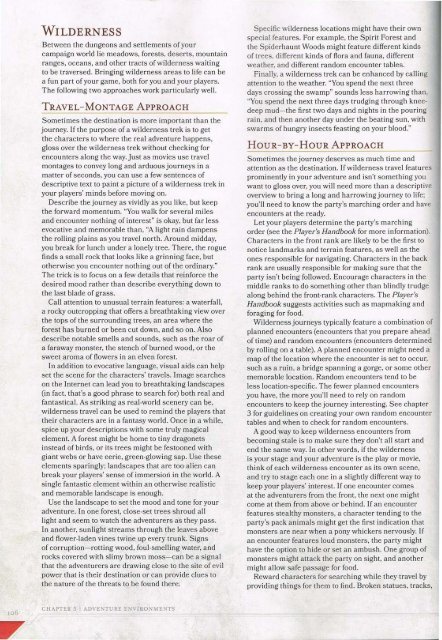Dungeon Master's Guide
You also want an ePaper? Increase the reach of your titles
YUMPU automatically turns print PDFs into web optimized ePapers that Google loves.
WILDERNESS<br />
Between the dungeons and settlements of your<br />
campaign world lie meadows, forests, deserts, mountain<br />
ranges, oceans, and other tracts of wilderness waiting<br />
to be traversed. Bringing wilderness areas to life can be<br />
a fun part of your game, both for you and your players.<br />
The following two approaches work particularly well.<br />
TRAVEL- MONTAGE APPROACH<br />
Sometimes the destination is more important than the<br />
journey. If the purpose of a wilderness trek is to get<br />
the characters to where the real adventure happens,<br />
gloss over the wilderness trek without checking for<br />
encounters along the way. Just as movies use travel<br />
montages to convey long and arduous journeys in a<br />
matter of seconds, you can use a few sentences of<br />
descriptive text to paint a picture of a wilderness trek in<br />
your players' minds before moving on.<br />
Describe the journey as vividly as you like, but keep<br />
the forward momentum. "You walk for several miles<br />
and encounter nothing of interest" is okay, but far less<br />
evocative and memorable than, "A light rain dampens<br />
the rolling plains as you travel north. Around midday,<br />
you break for lunch under a lonely tree. There, the rogue<br />
finds a small rock that looks like a grinning face, but<br />
otherwise you encounter nothing out of the ordinary."<br />
The trick is to focus on a few details that reinforce the<br />
desired mood rather than describe everything down to<br />
the last blade of grass.<br />
Call attention to unusual terrain features: a waterfall,<br />
a rocky outcropping that offers a breathtaking view over<br />
the tops of the surrounding trees, an area where the<br />
forest has burned or been cut down, and so on. Also<br />
describe notable smells and sounds, such as the roar of<br />
a faraway monster, the stench of burned wood, or the<br />
sweet aroma of flowers in an elven forest.<br />
In addition to evocative language, visual aids can help<br />
set the scene for the characters' travels. Image searches<br />
on the Internet can lead you to breathtaking landscapes<br />
(in fact, that's a good phrase to search for) both real and<br />
fantastical. As striking as real-world scenery can be,<br />
wilderness travel can be used to remind the players that<br />
their characters are in a fantasy world. Once in a while,<br />
spice up your descriptions with some truly magical<br />
element. A forest might be home to tiny dragonets<br />
instead of birds, or its trees might be festooned with<br />
giant webs or have eerie, green-glowing sap. Use these<br />
elements sparingly; landscapes that are too alien can<br />
break your players' sense of immersion in the world. A<br />
single fantastic element within an otherwise realistic<br />
and memorable landscape is enough.<br />
Use the landscape to set the mood and tone for your<br />
adventure. In one forest, close-set trees shroud all<br />
light and seem to watch the adventurers as they pass.<br />
In another, sunlight streams through the leaves above<br />
and flower-laden vines twine up every trunk. Signs<br />
of corruption-rotting wood, foul-smelling water, and<br />
rocks covered with slimy brown moss- can be a signal<br />
that the adventurers are drawing close to the site of evil<br />
power that is their destination or can provide clues to<br />
the nature of the threats to be found there.<br />
S pecific wilderness locations might have their own<br />
special features. For example, the Spirit Forest and<br />
the Spiderhaunt Woods might feature different kinds<br />
of trees, different kinds of flora and fauna, different<br />
weather. and different random encounter tables.<br />
Finally, a wilderness trek can be enhanced by calling<br />
attention to the weather. "You spend the next three<br />
days crossing the swamp" sounds less harrowing than,<br />
"You spend the next three days trudging through kneedeep<br />
mud- the first two days and nights in the pouring<br />
rain, and then another day under the beating sun, with<br />
swarms of hungry insects feasting on your blood."<br />
HouR-BY-HouR APPROACH<br />
Sometimes the journey deserves as much time and<br />
attention as the destination. If wilderness travel feature<br />
prominently in your adventure and isn't something you<br />
want to gloss over, you will need more than a descriptive<br />
overview to bring a long and harrowing journey to life;<br />
you'll need to know the party's marching order and have<br />
encounters at the ready.<br />
Let your players determine the party's marching<br />
order (see the Player's Handbook for more information).<br />
Characters in the front rank are likely to be the first to<br />
notice landmarks and terrain features, as well as the<br />
ones responsible for navigating. Characters in the back<br />
rank are usually responsible for making sure that the<br />
party isn't being followed. Encourage characters in the<br />
middle ranks to do something other than blindly trudge<br />
along behind the front-rank characters. The Player's<br />
Handbook suggests activities such as mapmaking and<br />
foraging for food.<br />
Wilderness journeys typically feature a combination of<br />
planned encounters (encounters that you prepare ahead<br />
of time) and random encounters (encounters determined<br />
by rolling on a table). A planned encounter might need a<br />
m~p of the location where the encounter is set to occur,<br />
such as a ruin, a bridge spanning a gorge, or some other<br />
memorable location. Random encounters tend to be<br />
less location-specific. The fewer planned encounters<br />
you have, the more you'll need to rely on random<br />
encounters to keep the journey interesting. See chapter<br />
3 for guidelines on creating your own random encounter<br />
tables and when to check for random encounters.<br />
A good way to keep wilderness encounters from<br />
becoming stale is to make sure they don't all start and<br />
end the same way. In other words, if the wilderness<br />
is your stage and your adventure is the play or movie,<br />
think of each wilderness encounter as its own scene,<br />
and try to stage each one in a slightly different way to<br />
keep your players' interest. If one encounter comes<br />
at the adventurers from the front, the next one might<br />
come at them from above or behind. If an encounter<br />
features stealthy monsters, a character tending to the<br />
party's pack animals might get the first indication that<br />
monsters are near when a pony whickers nervously. If<br />
an encounter features loud monsters, the party might<br />
have the option to hide or set an ambush. One group of<br />
monsters might attack the party on sight, and another<br />
might allow safe passage for food.<br />
Reward characters for searching while they travel by<br />
providing things for them to find. Broken statues, tracks,<br />
ro6<br />
CHAPTER 5 I ADVENTURE ENVIRONMENTS




